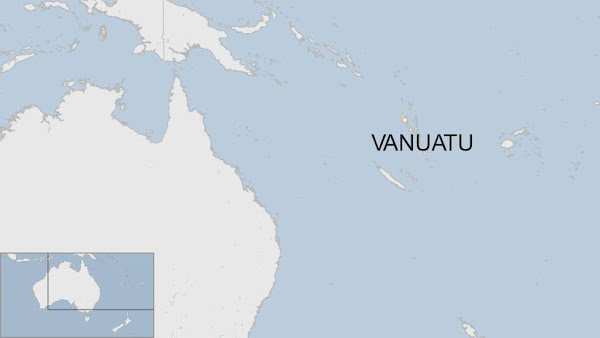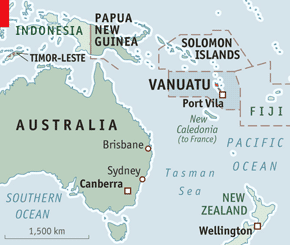New Hebrides, formally the New Hebrides Condominium (undefined, "Condominium of the New Hebrides"), was the colonial name for the collection of islands in the South Pacific Ocean that is now Vanuatu. The islands had been inhabited by indigenous people for three thousand years prior to the arrival of the first Europeans in 1606 on a Spanish expedition commanded by Portuguese navigator Pedro Fernandes de Queir3s. The islands were colonized in the 18th century by both the British and the French, immediately following Captain James Cook's voyage. The two nations finally agreed to create an Anglo-French condominium on the islands, dividing them into two distinct communities: one Anglophone and one Francophone. Even after independence, this division persists, with schools teaching in either one of the two languages and with distinct political parties. The condominium existed from 1906 until 1980, when the New Hebrides became the Republic of Vanuatu.
Geographic coordinates (latitude and longitude) specify a location on the surface of the Earth. Coordinates are expressed in angular units. The traditional representation of latitude and longitude is in degrees (°), minutes (â2), and seconds (â3). GPS systems often employ degrees and decimal minutes coordinates, or decimal degrees. Latitude fluctuates between â90° and 90°. The Equator's latitude is 0°; the South Pole's latitude is â90°; and the North Pole's latitude is 90°. Positive latitude values indicate sites north of the Equator (abbrev. N). Negative latitude values indicate sites south of the Equator (abbrev. S).
Climate change [edit]
Port Vila has a tropical climate, more precisely a tropical rainforest climate, with seasons that are markedly wetter and dryer. Due to the near-permanent trade winds and the frequent occurrence of cyclones at Port Vila, the climate is not equatorial but marine trade-wind tropical. [6] Annual rainfall averages around 2,338.9 millimetres or 92.08 inches, with March being the wettest month. September is the driest month. In an average year, there are 153 rainy days. Additionally, the region is influenced by south-east trade winds. Throughout the year, temperatures remain rather constant, and the record high is 35.6 °C or 96.1 °F. July is the coldest month, with an average high of 27°C or 80.6°F and a low of 18°C or 64.4°F. February is the warmest month, with an average high of 31.2°C or 88.2°F and a low of 23°C or 73.4°F. Port Vila's record low temperature is 8.5°C or 47.3°F. The humidity level is often high.
What is there to do in Port Vila?
Port Vila's Educational Institutions Consider the appearance of Port Vila's educational institutions, including its schools, colleges, and universities. Some even provide excursions to give you a better understanding of what they have to offer. Additionally, Port Vila is home to several architecturally beautiful libraries that not only house an abundance of books, but also serve as excellent study rooms. Universities in Port Vila: South Pacific University

















